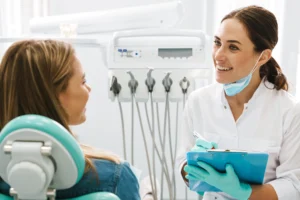Polyvinyl siloxane (PVS) has been a staple for dental impressions for decades. Known for its stability and detail reproduction, it improved on older impression materials and earned its place in everyday practice. But digital dentistry has evolved. PVS has not.
Modern practices rely on digital tools to reduce error, improve efficiency, and elevate the patient experience. When compared side by side, PVS introduces delays, discomfort, and inconsistencies that scanners simply do not.
The Problem with PVS in a Digital World
Even when used by skilled hands, PVS has built-in weaknesses:
- Technique Matters Too Much: Everything from tray size to removal angle can affect accuracy. A single misstep leads to distortion or air bubbles.
- Poor Patient Experience: Patients often gag or feel claustrophobic. Long set times and bulky trays create discomfort and anxiety.
- Physical Risk of Error: Models must be poured, packaged, and shipped. Any damage in this chain compromises the restoration.
- Storage and Access Challenges: PVS models take up physical space and are not instantly available when a case needs review or remaking.
These issues create inefficiencies that waste time and reduce the quality of care.
Why Digital Scanning Is a Better Alternative
Digital scanning eliminates the weak points of analog impressions:
- Accurate and Repeatable: Scanners capture exact data with no risk of distortion due to time, temperature, or handling.
- Better for Patients: No impression trays means less gagging and a more comfortable appointment overall.
- Better for Patients: Studies show that patients consistently prefer digital impressions over conventional PVS, citing higher comfort, reduced gag reflex, and a better overall experience. Based on this body of research, Incisive estimates that roughly 80% of patients would choose digital scanning when given the option. (Patel et al., 2017; Bahammam et al., 2022).
- Faster Turnaround: Digital files are sent to labs in minutes, not days. Cases move forward faster and more predictably.
- Smarter Records: Digital files are easy to store and retrieve. Reorders, remakes, and progress tracking become seamless.
Even better, these benefits apply across team members. Scans remain consistent no matter who captures them.
When Accuracy and Speed Matter Most
For full-arch restorations, aligner cases, night guards, and cosmetic work, precision matters. These cases often involve multiple steps, esthetic detail, and tight timelines. PVS struggles to deliver consistently in these situations, while digital scanning improves the odds of a smooth outcome on the first try.
A New Standard for Impressions
PVS impressions are no longer the gold standard. Today’s patients want modern, efficient care. Practices that still rely on PVS are adding complexity and cost where it is no longer necessary. Going digital streamlines care, boosts case acceptance, and positions your practice for long-term growth.
Upgrade Your Impression Workflow
If PVS is holding your workflow back, it is time to move forward. Incisive Dental helps practices transition to digital scanning with the right tools, training, and lab partnerships. Improve your process, increase efficiency, and create better patient experiences.
Schedule a call today to learn how to upgrade your impression workflow and unlock the full value of digital dentistry.



